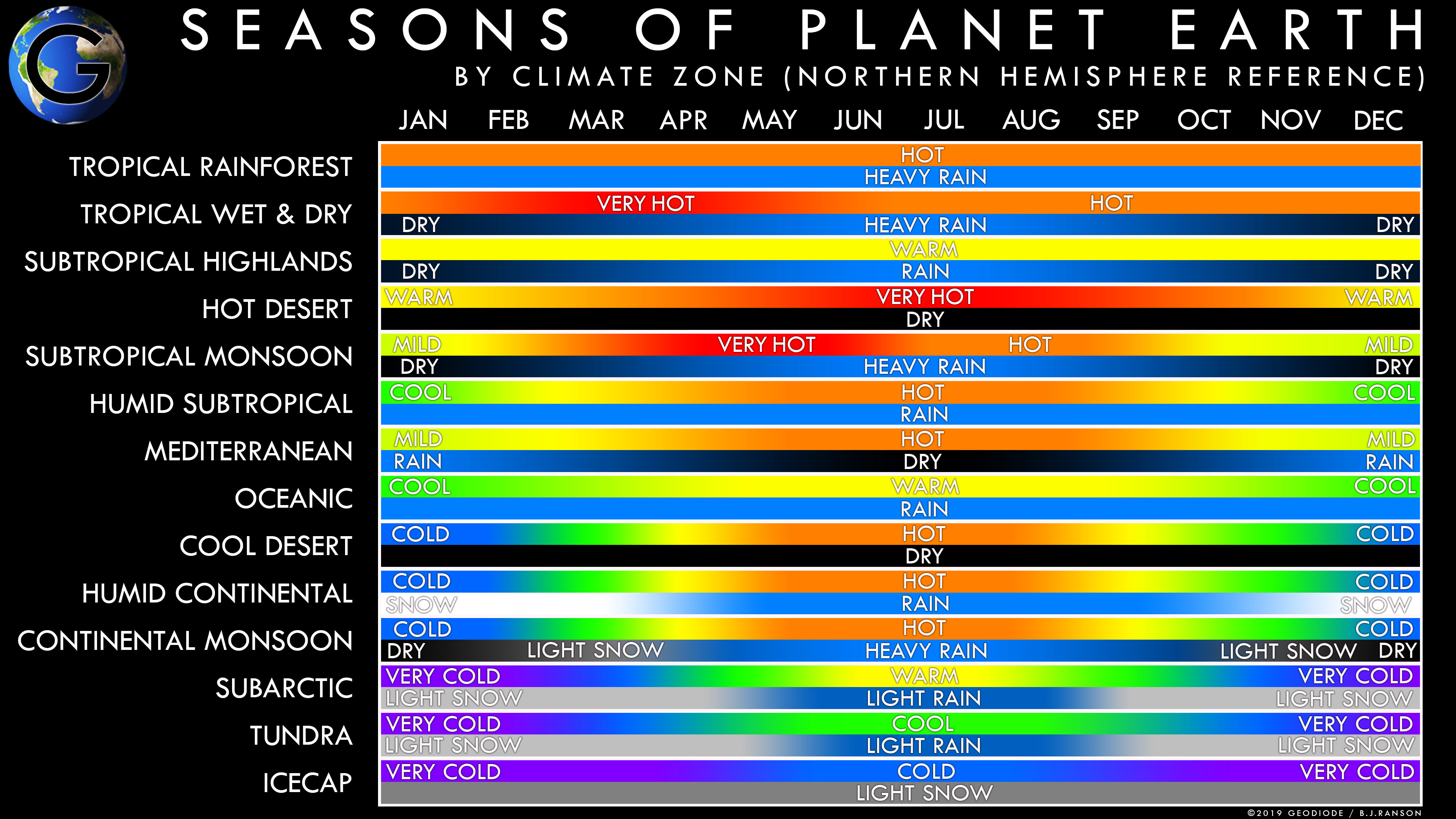Ecology
links: reference: YT - Geodiode 9-14-2021
Ecology #
Climate #
- Ocean proximity, altitude, slope direction, built environment, and plant cover can cause microclimates.
- Forests provide cooling from the sun with their canopy, while in winter the heat is kept in due to dark foliage.
- In the northern hemisphere, valleys that run east-west, the south-facing will see a sun at a steeper angle, becoming warmer.
- Ocean water has useful moderating effects over thousands of miles. It warms up the area significantly. It provides protection from frost.
- Tropical and subtropical plants, when exposed to any frost, can die off in just a few days.
- Tropical/subtropical islands subject to trade winds: when trade winds hit mountainous regions, orographic lift of air will result in more rainfall, leeching the ocean air of its moisture.

Köppen-Geiger Climate Classification #
https://www.youtube.com/watch?v=BsOL9Fafo2w&list=PLu83ZzwRbQvI1ULwqa_EP7z1wvOPLBB7u&index=1 For C/D, Second letter indicates the precipitation group, when there is a dry season (f=none, s=summer, w=winter). For B/C/D/E, the third (for E, second) letter represents the temperature subgroup, with a-d getting colder year-round.
A: Tropical #
-
Hot year-round, heavy rain as opposed to moderate/high in the subtropical regions
-
Af: Tropical rainforest
- Constant heat and humidity. Largest biodiversity on Earth.
- Vegetation: Its vegetation is of course, a rainforest, since it’s an amazing environment for wildlife.
- Locations: Amazon, Congo, SE Asia, trade wind coast
-
Am: Tropical Monsoon
- Heavy rain during part/most of the year, but has a drier season due to trade winds.
- Monsoon forest and grassland
- Amazon, W&C Africa, W India, SE Asia, Caribbean
-
Aw: Tropical Savannah
- Heavy rain during rainy season, but low or absent in the dry season. Has
- Scrub, forest, and grassland
- Widespread in all areas between 20°N & 20°S
B: Dry #
-
Subtropical or continental areas with very little rain year-round
-
BWh: Hot Desert
- Highest temperatures on earth, little to no vegetation or rainfall.
- SW USA, N Mexico, Sahara, Middle East, W Asia, SW Africa, Australia
-
BSh: Hot Semi-arid
- Very hot summer, mild winter. Low rainfall year-round. Has some scrub/cacti.
- Borders all hot deserts; marginal habitability
-
BWk: Cool Desert
- Very low rainfall.
- Warm/hot summer, cool/cold (we’re talking below freezing) winter.
- Very limited/absent vegetation.
- W USA, Atacama, Patagonia, Central Asia, SW Africa, S Australia
- Desolate & Inhospitable
-
BSk: Cool semi-arid
- Low rainfall , but more than deserts.
- Hotter, then colder. Extreme ranges, like the rest.
- Scrub, hardy grasses
- W USA, Andes Fringes, E Spain, Iran, Central Asia, S Africa, S Australia. Horse/steppe lands.
C: Temperate #
-
(Csa, Csb, Csc | Cwa, Cwb, Cwc | Cfa, Cfb, Cfc)
-
Mild temperature ranges, occuring near coasts
-
Cfa: Humid subtropical
- Moderate precipitation year-round
- Tropical summers and cool winters. Four seasons; ‘sultry summer but fresh winters’.
- Forest, grassland, swamp
- Eastern mid-latitude fringes, N Italy, S Japan, etc. Many world cities
-
Cwa: Subtropical Monsoon
- 3 seasons: very hot, dry summer, hot wet season, cool dry winter.
- Scrub-forest, grassland
- C. Mexico, Mid/S Africa, N India, N Vietnam, S China. Huge populations.
-
Csa: Hot summer mediterranean
- Hot, dry summer, mild, wet winter. Scrub.
- All western mid-latitude fringes, mediterranean. Tourist weather.
-
Csb: Warm summer mediterranean
- Unique, with stormy winters but superb summers.
- Warm to cool.
- Coniferous/Eucalyptus, redwood forest.
- Pacific NW, Mid-Chile, N Portugal, S Australia
-
Cwb & Cwc: Subtropical highland
- Wet and dry, forest and grassland. ‘Eternal’ spring climate.
- C. Mexico, Peru, Bolivia, C. Africa, S Himalayas
-
Cfb: Oceanic/Subtropical highland/Maritime
- Four seasons; highland is ’eternal spring’. Unreliable summers & stormy winters, frequent grey skies
- Mixed woodland
- W Canada, NW Europe, S. Chile, SE Australia, New Zealand, Andes highland
-
Cfc: Subpolar Oceanic
- ‘Perpetual autumn’, cool year round.
- W Iceland, N Norway, Scottish highlands, S Chile
D: Continental #
-
(Dsa, Dsb, Dsc, Dsd | Dwa, Dwb, Dwc, Dwd | Dfa, Dfb, Dfc, Dfd)
-
High temperature ranges, experiencing cold/very cold winters.
-
Dfa & Dfb: (Humid) continenal
- Distinct four seasons. Moderate/low precipitation.
- Prairie & steppe grass
- Mid latitude, northern continental interiorAs; Dfb: Great Lakes region; many world cities
-
Dwa & Dwb: Continental Monsoon
- Just like Dfa & Dfb, but drier winters. Moderate/low precipitation.
- N China (Beijing), Korea, Himalayas. Unique to east Asia, due to the monsoon.
-
Dsa & Dsb: Continental dry summer
- Hot & dry, then snow & cold. Moderate/low precipitation.
- Steppe grass & Shrub
- High altitude form of the mediterranean climate
-
Dfc & Dfd: Subarctic/Taiga
- Long, dark, snowy winters. Low precipitation year-round.
- Boreal forest (Taiga), swamp
- High latitude N continental interiors & isolated alpine
-
Dwc & Dwd: Subarctic monsoon
- Boreal forest
- Light snow in winter, with fairly low summer precipitation.
- Eastern Siberia, Tibetan Plateau. Very wide possible temperature range.
-
Dsc & Dsd: Subarctic dry summer
- Very low precipitation in summer, moderate/high snow in winter
- Very rare; isolated areas of N Rockies, Siberia, Kamchatka
- Very wide temperature range
- Boreal forest
E: Polar #
-
ET: Tundra
- Low precipitation year round (high in S Greenland)
- Like all the subarctic regions, has short summers and long, dark winters.
- Cool to very cold (60–22°F)
- Lichen, moss, hardy grasses, permafrost; bleak & treeless wastes; marginal habitability
- Arctic circle, cape horn, antarctic peninsula, alpine
-
EF: Icecap
- Below freezing year-round
- ‘Perpetual winter’… ‘most hostile and otherworldly of all zones’… badass brah
- Greenland ice sheet & Antarctica